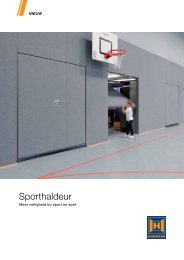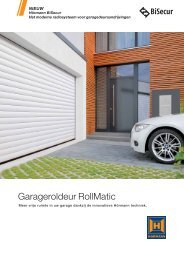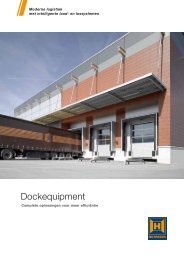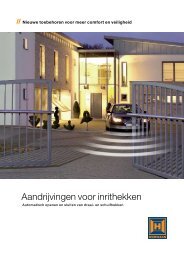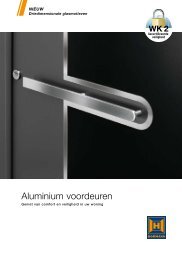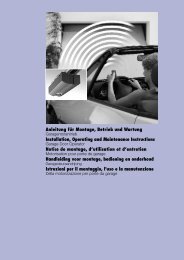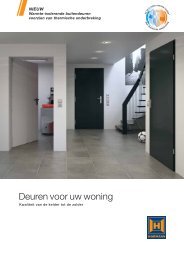2 - Hormann
2 - Hormann
2 - Hormann
Create successful ePaper yourself
Turn your PDF publications into a flip-book with our unique Google optimized e-Paper software.
2 DEFINITIONS<br />
52<br />
ENGLISH<br />
Hold-open phase<br />
Waiting phase at the OPEN end-of-travel position before<br />
the gate closes when using the automatic timer.<br />
Automatic timer<br />
Automatic closing of the gate following elapse of a set<br />
phase, after reaching the OPEN end-of-travel position.<br />
DIL switches<br />
Switches on the control unit circuit board for setting the<br />
controls.<br />
Through-traffic photocell<br />
When the gate is passed through, the photocell stops the<br />
hold-open phase and resets itself to a preset value.<br />
Travel leaf<br />
Leaf that is opened and closed along with the traffic leaf<br />
for through-traffic.<br />
Leaf offset<br />
The leaf offset ensures the correct closing order with<br />
overlapping fittings.<br />
Traffic leaf<br />
Leaf that is opened and closed for pedestrian traffic.<br />
Impulse operation/impulse control<br />
A sequence of impulses, which allows the gate to<br />
alternately OPEN-STOP-CLOSE-STOP.<br />
Force learning cycle<br />
A learning cycle during which the necessary forces are<br />
learned.<br />
Normal cycle<br />
Gate travel applying the learned distances and forces.<br />
Reference cycle<br />
Gate travel in the closing direction in order to lay down<br />
the standard setting.<br />
Reversing cycle<br />
Gate travels in the opposite direction after activation of<br />
the safety devices.<br />
Reversing limit<br />
The reversing limit separates the area between reversal<br />
or stopping of the gate when the force is cut off at the<br />
CLOSE end-of-travel position.<br />
Distance learning cycle<br />
The distances are learned during this cycle.<br />
Dead man's travel<br />
The gate travels only as long as the buttons are pressed.<br />
Advanced warning phase<br />
The time between the travel command (impulse) and the<br />
start of travel.<br />
Factory reset<br />
Resetting the learned values to the delivery status/ex<br />
factory setting<br />
Colour code for cables, single conductors and<br />
components<br />
The abbreviations of the colours for identifying the<br />
cables, conductors and components comply with the<br />
international colour code according to IEC 757:<br />
BK = black PK = pink<br />
BN = brown RD = red<br />
BU = blue SR = silver<br />
GD = gold TQ = turquoise<br />
GN = green VT = violet<br />
GN/YE = green/yellow WH = white<br />
GY = grey YE = yellow<br />
OG = orange<br />
3 PREPARATION FOR INSTALLATION<br />
Before installing the operator and in the interests of<br />
personal safety, make sure that any necessary repairs<br />
to the gate system are carried out by a qualified service<br />
engineer.<br />
Only correct fitting and maintenance in compliance with<br />
the instructions by a competent/specialist company or a<br />
competent/qualified person ensure safe and flawless<br />
operation of the system.<br />
The specialist carrying out the work must ensure that<br />
installation is conducted in compliance with the prevailing<br />
national regulations on occupational safety and those<br />
governing the operation of electrical equipment. In the<br />
process, the relevant national guidelines must be<br />
observed. Possible hazards are prevented by the design<br />
itself and by carrying out installation in accordance with<br />
our guidelines.<br />
Note<br />
The function of all the safety and protective devices, must<br />
be checked once a month and, if necessary, any faults or<br />
defects rectified immediately.<br />
CAUTION<br />
Only ever operate the hinged gate when you<br />
have full view of the movement range of the<br />
gate. Before driving in or out of the gateway,<br />
always check that the gate has fully opened.<br />
You must never drive or walk through gateways<br />
unless the entrance gate has reached the OPEN<br />
end-of-travel position. In addition, check the<br />
entire gate system (gate pivots, bearings and<br />
fastenings) for wear and possible damage.<br />
Check for signs of rust, corrosion or fractures.<br />
The gate system may not be used if repair or<br />
adjustment work needs to be carried out. Always<br />
remember that a fault in the gate system or a<br />
misaligned gate can cause severe injury. ➤<br />
08.2007 TR10A028-A RE



